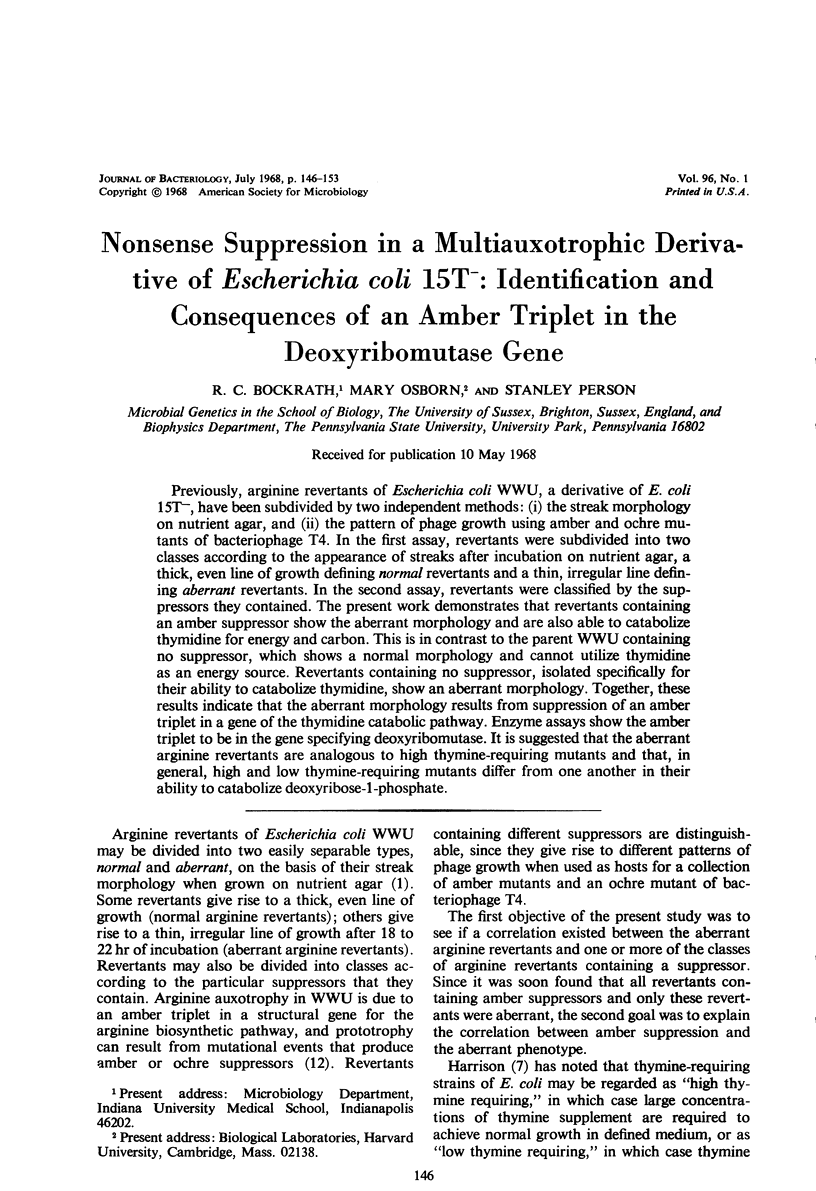Nonsense Suppression in a Multiauxotrophic Derivative of Escherichia coli 15T−: Identification and Consequences of an Amber Triplet in the Deoxyribomutase Gene (original) (raw)
Abstract
Previously, arginine revertants of Escherichia coli WWU, a derivative of E. coli 15T−, have been subdivided by two independent methods: (i) the streak morphology on nutrient agar, and (ii) the pattern of phage growth using amber and ochre mutants of bacteriophage T4. In the first assay, revertants were subdivided into two classes according to the appearance of streaks after incubation on nutrient agar, a thick, even line of growth defining normal revertants and a thin, irregular line defining aberrant revertants. In the second assay, revertants were classified by the suppressors they contained. The present work demonstrates that revertants containing an amber suppressor show the aberrant morphology and are also able to catabolize thymidine for energy and carbon. This is in contrast to the parent WWU containing no suppressor, which shows a normal morphology and cannot utilize thymidine as an energy source. Revertants containing no suppressor, isolated specifically for their ability to catabolize thymidine, show an aberrant morphology. Together, these results indicate that the aberrant morphology results from suppression of an amber triplet in a gene of the thymidine catabolic pathway. Enzyme assays show the amber triplet to be in the gene specifying deoxyribomutase. It is suggested that the aberrant arginine revertants are analogous to high thymine-requiring mutants and that, in general, high and low thymine-requiring mutants differ from one another in their ability to catabolize deoxyribose-1-phosphate.

Selected References
These references are in PubMed. This may not be the complete list of references from this article.
- Bockrath R. C. Evidence for two geometrically distinct targets mediating arginine reversion in E. coli. Mutat Res. 1967 Nov-Dec;4(6):871–873. doi: 10.1016/0027-5107(67)90095-4. [DOI] [PubMed] [Google Scholar]
- Breitman T. R., Bradford R. M. The absence of deoxyriboaldolase activity in a thymineless mutant of Escherichia coli strain 15: a possible explanation for the low thymine requirement of some thymineless strains. Biochim Biophys Acta. 1967 Mar 29;138(1):217–220. doi: 10.1016/0005-2787(67)90610-7. [DOI] [PubMed] [Google Scholar]
- Garen A., Garen S., Wilhelm R. C. Suppressor genes for nonsense mutations. I. The Su-1, Su-2 and Su-3 genes of Escherichia coli. J Mol Biol. 1965 Nov;14(1):167–178. doi: 10.1016/s0022-2836(65)80238-8. [DOI] [PubMed] [Google Scholar]
- HOFFMANN C. E., LAMPEN J. O. Products of desoxyribose degradation by Escherichia coli. J Biol Chem. 1952 Oct;198(2):885–893. [PubMed] [Google Scholar]
- Harrison A. P., Jr Thymine incorporation and metabolism by various classes of thymine-less bacteria. J Gen Microbiol. 1965 Dec;41(3):321–333. doi: 10.1099/00221287-41-3-321. [DOI] [PubMed] [Google Scholar]
- Kaplan S., Stretton A. O., Brenner S. Amber suppressors: efficiency of chain propagation and suppressor specific amino acids. J Mol Biol. 1965 Dec;14(2):528–533. doi: 10.1016/s0022-2836(65)80202-9. [DOI] [PubMed] [Google Scholar]
- Osborn M., Person S., Phillips S., Funk F. A determination of mutagen specificity in bacteria using nonsense mutants of bacteriophage T4. J Mol Biol. 1967 Jun 28;26(3):437–447. doi: 10.1016/0022-2836(67)90314-2. [DOI] [PubMed] [Google Scholar]
- PERSON S., BOCKRATH R. C., Jr DIFFERENTIAL MUTATION PRODUCTION BY THE DECAY OF INCORPORATED TRITIUM COMPOUNDS IN E. COLI. Biophys J. 1964 Sep;4:355–365. doi: 10.1016/s0006-3495(64)86788-6. [DOI] [PMC free article] [PubMed] [Google Scholar]
- RACKER E. Enzymatic synthesis and breakdown of desoxyribose phosphate. J Biol Chem. 1952 May;196(1):347–365. [PubMed] [Google Scholar]
- RAZZELL W. E., KHORANA H. G. Purification and properties of a pyrimidine deoxyriboside phosphorylase from Escherichia coli. Biochim Biophys Acta. 1958 Jun;28(3):562–566. doi: 10.1016/0006-3002(58)90519-5. [DOI] [PubMed] [Google Scholar]
- Roepke R. R. Relation between different thymineless mutants derived from Escherichia coli. J Bacteriol. 1967 Mar;93(3):1188–1189. doi: 10.1128/jb.93.3.1188-1189.1967. [DOI] [PMC free article] [PubMed] [Google Scholar]